Click on images to enlarge

habit (Photo: Trevor James)
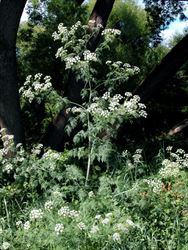
habit (Photo: Greg Jordan)
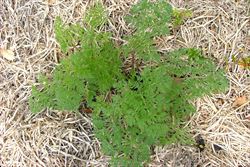
basal rosette of large, highly-divided, lower leaves (Photo: Sheldon Navie)
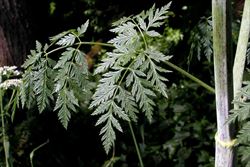
stem and upper leaf (Photo: Greg Jordan)
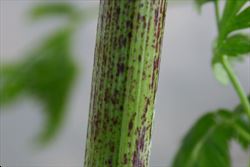
close-up of stem showing purplish blotches (Photo: Trevor James)

close-up of leaf stalks (Photo: Sheldon Navie)

close-up of highly-divided leaf (Photo: Sheldon Navie)
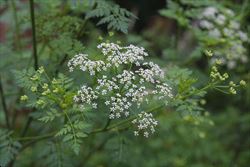
upper leaves and compound flower clusters (Photo: Trevor James)
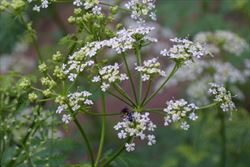
close-up of flowers (Photo: Trevor James)
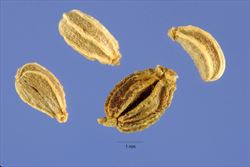
close-up of seeds (Photo: Steve Hurst at USDA PLANTS Database)
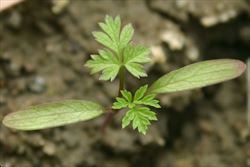
close-up of seedling (Photo: Trevor James)
Scientific Name
Conium maculatum L.
Synonyms
Coriandrum maculatum RothSium conium Vest
Family
Apiaceae (Queensland, New South Wales, the ACT, Victoria, Tasmania, Western Australia and the Northern Territory)Umbelliferae (South Australia)
Common Names
bunk, California fern, carrot fern, fool's parsley, hemlock, poison fool's parsley, poison hemlock, poison parsley, poison root, snake weed, spotted hemlock, spotted parsley, wild carrot, wild parsnip, winter fern, wode whistle
Origin
This species is native to Europe (i.e. Denmark, Finland, Ireland, Norway, Sweden, UK, Austria, Belgium, Czechoslovakia, Germany, Hungary, the Netherlands, Poland, Switzerland, Belarus, Estonia, Latvia, Lithuania, Moldova, Ukraine, Albania, Bulgaria, Greece, Italy, Romania, Yugoslavia, France, Portugal and Spain), northern Africa (i.e. Algeria, Morocco, Tunisia and Ethiopia), western Asia, China and the Indian Sub-continent (i.e. northern India and northern Pakistan).
Cultivation
Hemlock (Conium maculatum) was occasionally deliberately grown as a medicinal herb in the past, even though it is highly poisonous. It is generally considered a weed of gardens these days.
Naturalised Distribution
A widespread species that is mainly naturalised in the south-eastern parts of Australia. It is most common in the coastal and sub-coastal regions of Victoria, in eastern New South Wales, in the ACT and in Tasmania. Also scattered in south-eastern Queensland, south-eastern South Australia and south-western Western Australia, and recorded in other parts of Victoria, Queensland, New South Wales and Western Australia.
Naturalised overseas in southern Africa, New Zealand, USA, Canada, Central America and South America.
Habitat
A weed of temperate, and to a lesser extent sub-tropical, environments that is usually found in damp, shaded habitats. It inhabits waterways, floodplains, marshes, wetlands, gullies, forest margins, roadsides, waste areas, disturbed sites, crops and pastures.
Habit
An upright (i.e. erect) and short-lived (i.e. annual or biennial) herbaceous plant usually growing 1-2 m tall, but occasionally reaching up to 3 m in height. This species forms a basal rosette of leaves during the early stages of growth.
Distinguishing Features
- an upright and short-lived herbaceous plant usually growing 1-2 m tall with stems covered in distinctive purplish blotches.
- its stems are also hollow, hairless and have fine lengthwise grooves.
- its stems and leaves give off a strong odour when crushed or damaged.
- its leaves are large, deeply-divided, and ferny in appearance and their stalks tend to sheath the stems at their bases.
- its small white flowers (2-4 mm across) are produced in large dense flat-topped clusters at the tips of the branches.
- its small greyish-brown fruit separate into two prominently ribbed 'seeds' (2-4 mm long) when mature.
Seedling
At germination the two seed leaves (i.e. cotyledons) are long and narrow (i.e. lanceolate) in shape. The first true leaves are hairless and have two or three main sub-divisions, each of which is deeply toothed or divided into several smaller lobes.
Stems and Leaves
The branched stems are hairless (i.e. glabrous), mostly hollow, and have fine lengthwise (i.e. longitudinal) grooves. They are pale green in colour but covered in distinctive purplish or pinkish blotches.
The alternately arranged leaves are borne on long hollow leaf stalks (i.e. petioles) that tend to sheath the stem at their bases. They are deeply divided (i.e. bi-pinnatisect), with toothed (i.e. serrate) segments, and are ferny in appearance. These leaves (up to 50 cm long and 40 cm wide, but more commonly 12-25 cm long) are hairless (i.e. glabrous). The upper leaf surfaces are dark green in colour, while their undersides are a paler green or greyish-green. The stems and leaves give off a strong odour when crushed or damaged.
Flowers and Fruit
The white flowers are borne in large numbers in dense flat-topped clusters at the tips of the branches (i.e. in terminal compound umbels). Individual flowers are small (2-4 mm across), have five incurved petals and five stamens, and are borne on stalks (i.e. pedicels) up to 5 cm long. Many (about 15) of these stalks (i.e. pedicels) radiate from the same point and form a small cluster of flowers (i.e. an umbel), with several (6-20) of these smaller clusters (often called rays) being grouped together into a much larger cluster (i.e. a compound umbel) that is subtended by several small leafy bracts (about 5 mm long). Flowering occurs mostly during spring and summer.
The fruit turns from green to greyish-brown in colour as it matures and resembles a capsule. It actually consists of two one-seeded structures (i.e. mericarps) that readily split apart when the fruit is fully mature. Each of these 'seeds' (2-4 mm long) is hairless (i.e. glabrous), but has five prominent yellowish-coloured ribs.
Reproduction and Dispersal
This plant reproduces by seed, which may be spread by machinery, vehicles, water, and wind. They may also be dispersed in dumped garden waste and in contaminated agricultural produce (e.g. fodder).
Environmental Impact
Hemlock (Conium maculatum) is regarded as an environmental weed in Victoria, the ACT, South Australia and Tasmania. It is primarily a weed of disturbed sites, often being found near stockyards, in waste areas and along roadsides. As an environmental weed it is mainly a problem in wetlands and along waterways (i.e. in riparian vegetation), although it has also invaded lowland grasslands and grassy woodlands and warm temperate rainforests in Victoria.
Other Impacts
All parts of this plant contain several pyridine alkaloids which are very poisonous to both humans and livestock, and handling the plant may also cause allergic dermatitis in some people. It may replace more useful plants in pastures, reducing carrying capacities in some situations, and also taints milk if ingested in low quantities. Though it occasionally also grows in crops, it rarely casues significant economic losses.
Legislation
This species is declared under legislation in the following states and territories:
- New South Wales: Class 4 - a locally controlled weed. The growth and spread of this species must be controlled according to the measures specified in a management plan published by the local control authority and the plant may not be sold, propagated or knowingly distributed (in a large number of local authority areas). See the New South Wales Department of Primary Industries Noxious Weeds List at http://www.dpi.nsw.gov.au for more detailed information on which local areas are covered in these declarations.
- Victoria: C7 - a regionally controlled weed in the Glenelg, Corangamite, Port Phillip West, Port Phillip East, North East, West Gippsland and East Gippsland regions, where landholders must take all reasonable steps to control it and prevent its spread on their land and the roadsides which adjoin their land.
- Western Australia: Prohibited - on the prohibited species list and not permitted entry into the state.
Management
For information on the management of this species see the following resources:
- the Victorian Department of Sustainability and Environment Landcare Note on this species, which is available online at http://www.dse.vic.gov.au.
Similar Species
Hemlock (Conium maculatum) is similar to Bishop's weed (Ammi majus), coriander (Coriandrum sativum), water parsnip (Berula erecta), wild carrot (Daucus carota), fennel (Foeniculum vulgare), water dropwort (Oenanthe pimpinelloides) and celery (Apium graveolens). These species can be distinguished by the following differences:
- hemlock (Conium maculatum) has purplish spotted stems and gives off a strong smell when its leaves are crushed. Its large compound flower clusters are made up of several (6-20) smaller clusters of tiny flowers (i.e. the inflorescence is a compound umbel). These flowers are white and their incurved petals are roughly all the same size. It produces slightly elongated (i.e. ovoid or ellipsoid) fruit that are prominently ribbed.
- Bishop's weed (Ammi majus) does not have spotted stems and does not give off a strong smell when its leaves are crushed. Its large compound flower clusters are made up of numerous (20-40) smaller clusters of tiny flowers (i.e. the inflorescence is a compound umbel). These flowers are white and their petals are roughly all the same size. It produces slightly elongated (i.e. ovoid or ellipsoid) fruit that are prominently ribbed.
- coriander (Coriandrum sativum) does not have spotted stems and gives off a strong smell when its leaves are crushed. Its large compound flower clusters are made up of a few (3-8) smaller clusters of flowers (i.e. the inflorescence is a compound umbel). These flowers are either pale pink, mauve or white and their petals vary in size (i.e. the outwards facing petals of the outer flowers of each small cluster are much larger). It produces almost rounded (i.e. sub-globular) fruit that are only slightly ribbed.
- water parsnip (Berula erecta) does not have spotted stems and does not give off a strong smell when its leaves are crushed. Its large compound flower clusters are made up of several to numerous (6-30) smaller clusters of tiny flowers (i.e. the inflorescence is a compound umbel). These flowers are white and their petals are roughly all the same size. It produces slightly elongated (i.e. ovoid or ellipsoid) fruit that are prominently ribbed.
- wild carrot (Daucus carota) does not have spotted stems and does not give off a strong smell when its leaves are crushed. Its large compound flower clusters are made up of numerous (30-60) smaller clusters of flowers (i.e. the inflorescence is a compound umbel). These flowers are mostly white, however the central flower of each cluster is pink, red or purplish, and their petals vary in size (i.e. the outwards facing petals of the outer flowers of each small cluster are often much larger). It produces slightly elongated (i.e. ovoid or ellipsoid) ribbed fruit that are covered with bristles.
- fennel (Foeniculum vulgare) does not have spotted stems and gives off a strong smell when its very finely divided leaves are crushed. Its large compound flower clusters are made up of several to numerous (8-30) smaller clusters of tiny flowers (i.e. the inflorescence is a compound umbel). These flowers are yellow and their petals are roughly all the same size. It produces slightly elongated (i.e. ovoid or oblong) fruit that are prominently ribbed.
- water dropwort (Oenanthe pimpinelloides) does not have spotted stems and does not give off a strong smell when its leaves are crushed. Its large compound flower clusters are made up of several (6-12) smaller smaller clusters of tiny flowers (i.e. the inflorescence is a compound umbel). These flowers are white and their petals vary in size (i.e. the outwards facing petals of the outer flowers of each small cluster are somewhat larger). It produces slightly elongated (i.e. ovoid or ellipsoid) fruit that are prominently ribbed.
- celery (Apium graveolens) does not have spotted stems and gives off a strong smell when its leaves are crushed. Its large compound flower clusters are made up of few to several (4-16) smaller clusters of tiny flowers (i.e. the inflorescence is a compound umbel). These flowers are white and their petals are roughly all the same size. It produces almost rounded (i.e. sub-globular) or slightly elongated (broadly ovoid) fruit that are only slightly ribbed.
Hemlock (Conium maculatum) is also relatively similar to the elderberries (Sambucus spp.). However the elderberries (Sambucus spp.) do not have spotted stems and their fruit are berry-like (i.e. drupes).

